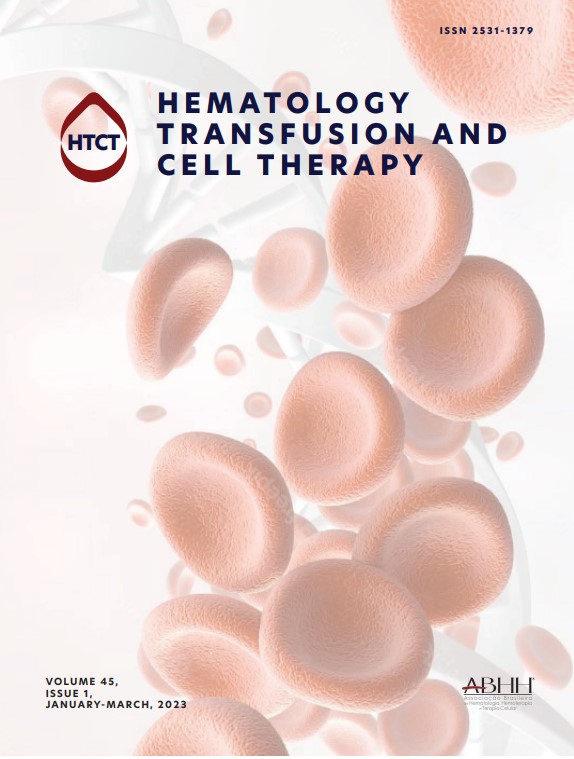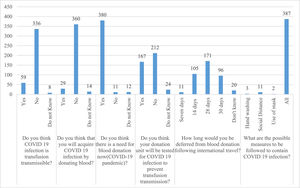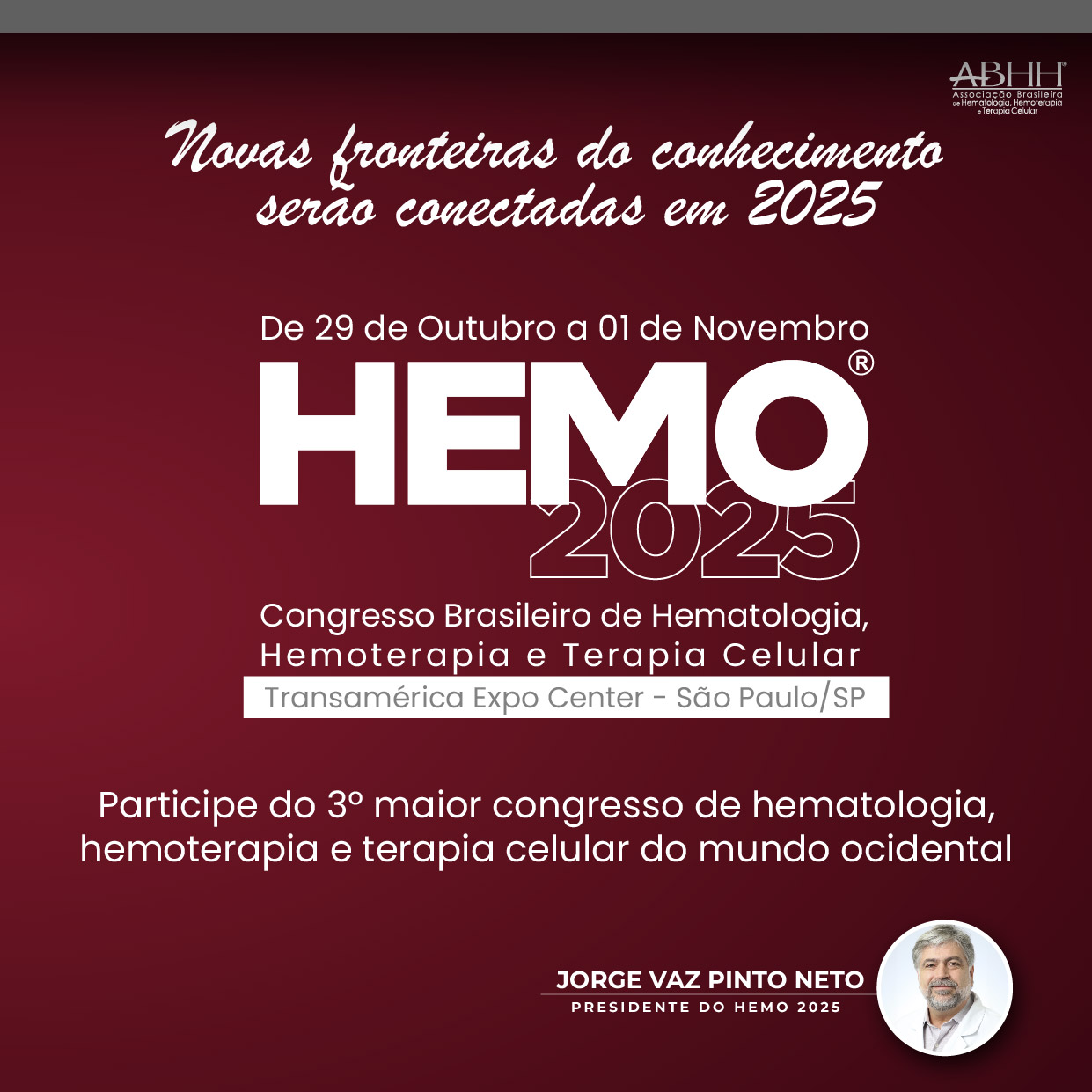Knowledge, Attitude and Practices (KAP) surveys prove beneficial to the transfusion services by providing an insight into the donors and, thus, aiding in mobilizing and retaining voluntary blood donors. We aim to study the knowledge, attitude and practices of donors towards blood donation in a pandemic setting.
MethodsA cross-sectional observational study to assess the knowledge, attitude and practices of blood donors was conducted between June to and October 2020. Non-parametric tests (Mann – Whitney U and Kruskal – Wallis) were performed to evaluate the relation of knowledge, attitude and practices overall scores with age group, gender and history of blood donations (first vs. repeat). The Chi-Square test/Fisher's Exact test was used to evaluate the differences in the distribution of Knowledge, Attitude and Practices items within the groups.
ResultsA total of 403 of 2,748 individuals who came for whole blood donation participated in the study. The mean age of the study population was 31.1years (SD ± 8.4 range: 18 - 58), with 75% of the donors donating for the first time. The fear of acquiring COVID-19 infection was perceived as a major reason for the eligible population not to donate. The overall knowledge, attitude and practice score among the donors was satisfactory, being 76.14%, with a significant association with age. The overall positive attitude and practices scores of blood donors were 85.48% and 78.04%, respectively.
ConclusionThe KAP scores were satisfactory among the donors. Timely communication of the precautionary measures at blood centers to contain the spread of the COVID-19 infection and effective counseling would help in motivating and retaining blood donors.
The World Health Organization (WHO) reported the novel coronavirus (COVID-19) outbreak as a public health emergency of international concern on January 30, 2020 and soon declared it a global pandemic on March 11, 2020.1 Due to this, the Central and State governments of India implemented a precautionary measure of national lockdown initiating March 23, 2020 to contain the spread of COVID-19. This unforeseen situation has dramatically affected healthcare services globally. In particular, this poses a significant challenge to blood transfusion services, which are primarily dependent on voluntary blood donors, to meet their continuous demand for blood transfusion.2 In general, the pandemic has caused a decrease in the number of blood donations throughout the world.3 Amidst this reduction, blood centers were able to sustain the demand because of the altruistic voluntary donors who supported the blood centers. This study aimed to evaluate the knowledge, attitude and practices of blood donors who turned presented themselves for blood donation during the Covid -19 pandemic. Unlike other situations in which there might be increased blood donation, this is a situation in which blood donations decreased because of confinement strategies.
Knowledge, attitude and practices (KAP) surveys are representative of a specific population to collect information on what is known, believed and done about a particular topic and are the most frequently used study tool in health-seeking behavior research.4 With this background, we aimed to investigate the blood donor perspective during the COVID-19 pandemic as to what people know about blood donation during the COVID pandemic and how they feel and behave by conducting a KAP study. It helps bridging the gap and acts as a linking tool between health care personnel and the community to create awareness and emphasize the facts towards blood donation. It serves as an awareness program for the community related to blood donation and the COVID pandemic. It also helps transfusion services be prepared for such a situation in the future regarding how to create awareness and make the community aware of the myths and facts.
MethodsA cross-sectional observational study was conducted on donors who volunteered for whole blood donation to our blood center between June and October 2020. The study details were explained by giving an information sheet and a questionnaire was given to the donors after obtaining informed consent. A structured questionnaire to assess the knowledge, attitude and practices of blood donation among donors during the COVID-19 pandemic was prepared and validated by two subject experts in the field. The questionnaire was piloted among 10 donors before use. It consisted of six questions related to knowledge, which consisted of measures to be followed during blood donation in the COVID-19 pandemic, two questions related to their attitude towards blood donation during the pandemic and four questions related to their practices towards blood donation. It also consisted of three survey-based questions concerning the donation experience during the pandemic, such as reasons for eligible people not donating blood during the pandemic, requirement for an appointment letter or transportation facility to come for blood donation and whether they faced any inconvenience during the blood donation process. The questionnaire was also translated to the local language (Kannada), so that every participant could understand and make the survey unbiased.
Using a population size of 20,000, which is the average annual rate of the collection at our blood center, representing the donor population size, with a confidence interval of 95% and a margin of error of 5% and having a response distribution of 50%, the recommended sample size was calculated to be 377. Given potential non-responses and to increase study accuracy the sample size was increased to 403. The data obtained included age, gender, blood group, first-time or repeat donors and their responses to questions. The characteristics of donors at the blood center during the study period, such as age and gender, were compared with that of the pre-pandemic phase (6 months of data of the year 2019). These donors were categorized into three groups of age (18 - 25, 26 - 49 and over 49 years) and the number of individuals who donated blood were compared before and during the study period of the pandemic. Ethical clearance to conduct this study was obtained from the Institutional Ethics Committee .
Statistical analysisEach correct answer was given a score of 1 and an incorrect answer was given a score of 0 and a total score for Knowledge, Attitude and Practices and overall scores were obtained. The Shapiro Wilk test was performed to evaluate the distribution of the data. Data showed non-normal distribution, hence non-parametric tests (Mann – Whitney U and Kruskal – Wallis ANOVA) were performed to evaluate the relation of Knowledge, Attitude and Practices and overall scores with age group, gender and history of blood donations. The Chi-Square test/Fisher's Exact test was used to evaluate the significant differences in the distribution of Knowledge, Attitude and Practices items with gender, age group and history of blood donation. All the analysis was performed using the SPSS version 20. A p-value of < 0.05 was considered statistically significant.
ResultsDuring the study period, a total of 2,748 individuals presented themselves for blood donation at our center, of which 403 donors participated in the study. The total number of male donors was 383 (95%), with a male: female ratio of 19:1. The study participant mean age was 31.1 years (SD: 8.4), ranging from 18 to58. Among the total study population, 46.1% were of the O group, 25.3% of the A, 21.3% of the B and 6.9% were of the AB. The number of donors who donated for the first time was 304 (75%). The number of previous donations among repeat donors ranged from 1 to 8 times and 50.5% (50/99) of them had donated blood once before. The response to the questions related to knowledge, attitude and practices is summarized in Figures 1, 2 and 3, respectively. Figure 4 summarizes the responses of the study population to survey-based questions.
- ➢
Knowledge → The overall knowledge score of the understanding of the right facts towards blood donation and COVID -19 among our donor population was 76.14% (± 18.90). Almost all the donors were aware of the need for blood donation ((94.3%), measures to be taken to contain the spread of the COVID-19 infection (96%), blood donation does not carry the risk of acquiring COVID-19 infection (89.3%) and that COVID-19 infection is not transfusion-transmittable (83.3%). Close to half the number of donors was familiar with the deferral period following travel history (42.4%) during this pandemic and thought that their blood would be tested for COVID-19 infection following donation (41.4%).
- ➢
Attitude → On the whole, the majority of our donor population had a positive attitude towards blood donation with an overall attitude score of 85.48% (± 26.75). About two-thirds (61.1%) of the donors donated out of altruism and most of the donors felt it was safe to donate blood during the pandemic and agreed to be contacted for future donations (83.1% and 87.8%, respectively).
- ➢
Practices → The donor population had good practices with an overall practices score of 78.04% (± 21.99). Most of the donors (98%) followed the safety precautions during blood donation to contain the spread and approximately half of the total donors would contact the nearest hospital, as well as report to the blood bank, upon contracting infection post-donation. More than two-thirds (67.7%) of the donors would like to become regular blood donors and more than half of the donors (57.8%) was ready to encourage friends and family members for blood donation.
The overall mean knowledge score was significantly higher among donors over 30 years of age than their counterparts. There were no other significant differences in the mean knowledge, attitude and practices scores with the age group, sex, or history of blood donation (Table 1).
The relation of overall scores of knowledge, attitude and practices with the age group, gender and history of blood donations.
Footnote: SD→ Standard Deviation
Males had significantly higher knowledge about the need for blood donation and felt it was safe to donate blood during the pandemic, compared to females. Though the male to female ratio is disproportionate, the results may be interpreted with caution because, in general, the proportion of female donors is lower at our center (15:1 to 17:1) and during the pandemic phase the ratio was 19:1. The practice to come forward for blood donation upon receiving a message about the acute shortage of blood was significantly higher among repeat donors, compared to first-time donors. Donors over 30 years old had sound knowledge about the transfusion transmission of COVID -19 and the testing of the donated unit for COVID-19 following blood donation, compared to donors under 30 (p < 0.05). There was no other significant association between the groups. (Tables/Results not shown)
The age and gender characteristics before and during the study period are as below. During the pre-pandemic phase, a total of 7,360 donors donated, of which 398 were females and 6,962 were males, with a male to female ratio of 17:1. Though there was a decrease in the number of female donors during the pandemic phase, there was no significant difference, compared to the pre-pandemic phase. There was significant decrease in the number of individuals who donated blood in the age group of 18 to25 years before the pandemic (2826/7360) and during the study period (123/403). There was a significant increase in the number of individuals who donated blood in the age group of 26 to49 years before the pandemic (4256/7360) and during the study period (269/403). There was no significant difference in the number of individuals who donated blood in the age group over 49 years.
DiscussionTo curtail the spread of the COVID-19 pandemic, many countries, including India, adopted the option of lockdown by limiting the movement of people within their local regions, except for essential services.5 This affected blood transfusion services in the worst manner, in terms of mobilizing donors or donor recruitment or holding blood donation drives.6-10 At the outset, there was a huge gap between the demand and supply of blood products in India. The lockdown added fuel to the fire, by further decreasing the eligible population from blood donation.11 The transfusion services needed to adopt several mitigation strategies to meet the existing demand.11 This survey gave us an insight into the donor perspective towards blood donation during the pandemic.
Several mitigation strategies were adopted by the blood center to recruit blood donors. One of the mitigation strategies adopted by the blood center staff was to circulate messages/flyers/ about requirement for blood donation in social media platforms, such as Whatsapp, Facebookand Twitter requesting eligible people to come forward for blood donation. The male to female ratio of blood donors is high because, in general, the percentage of females donating blood is quite lower at our center and could be the reason for the low response rate from female donors.12 The overall knowledge scores were significantly higher among donors over 30 years of age. Thus, the focus should be on the younger generation, who are the most eligible population, with a longer duration of eligibility for donation, making them aware of the facts of COVID-19 related to blood donation and transfusion. It is important to sensitize this group with the right facts, as they are the most susceptible to peer group influence. Although most of the donors (83.3%) answered that COVID-19 is not transfusion transmittable, still more than one-third (41.4%) of the donors were under the wrong notion that their blood would be tested for COVID-19 infection. The reason for this could be the thought to increase the recipient safety and prevent the unproven risk existing with transfusion-transmitted COVID-19 infection. Most of the donors (89.3%) knew that the blood donation process, with the appropriate precautionary measures, will not carry the risk of acquiring COVID-19 infection. This was comparable to other surveys conducted.13,14
More than two-thirds (63%) of the donors felt that most eligible donors do not come forward for donation because of the risk of acquiring COVID-19 infection and that is the most common deterrent factor to blood donation among the public, as stated in earlier studies15 and is expected during a pandemic spread by the respiratory route.16 Most of the donors (91.6%) did not face any inconvenience during the current blood donation process. This was mainly because of the additional precautions and modified standard operating procedures (SOPs) adopted by the blood center to make the donation process smooth, while following the additional precautionary measures. However, a very minor part of the donors (5.4%) faced inconvenience like increased time for donation process that is inevitable to fulfill the additional safety measures, such as hand sanitization at each step of the donation process, decreased number of donation couches to collect from the donors due to the practice of social distancing and change of disposable covers after each donation to contain the spread of the virus.
Most of the donors (90.6%) did not require any additional measures, such as donation appointment letter/transport facility. This is because the lockdown in India was partially lifted by the time the study was initiated. However, 6.9% of people still required additional measures for blood donation due to restrictions imposed on their residential areas.17 The attitude and practices were satisfactory among the donors. Although three-fourths (75%) of the donors were first-time donors, most of them (88%) were ready to encourage friends and family members to donate blood and 62.8% were ready to become regular donors and continue blood donation. This promising attitude towards blood donation and commitment for further motivation of people towards blood donation is an encouraging finding and an incentive to the blood donation center. The number of first-time donors before the pandemic ranged from 55to 70% in the past 3 years, with an average of 65%. The blood center is attached to an educational institution offering multiple courses. Most of our donors include students from these different institutes who are motivated and aware of the need for blood and blood components. They are a moving population and, hence, the rate of first-time donors is approximately 55to 70%. This could also be the reason for a significant decrease in the number of individuals within the age range of 18to 25 years donating blood during the study period, compared to the pre-pandemic phase.
Approximately two-thirds (62.3%) of the donors stated they would report to the blood bank if they develop COVID-19 infection following blood donation. This responsible behavior of the donors may be because of the appropriate instructions given by the staff to the donors during pre-donation counseling. As per the regulatory guidelines laid down by the authorities, the blood units of a donor need to be discarded if the donor tests positive for COVID-19 infection and if transfused, the treating physician of the recipient is to be informed and monitored for COVID-19 symptoms.18 The effectiveness of the communication from the blood center and the responsibility of the donors towards society is reflected in the response of the donors.
LimitationThis study was conducted during the first phase of the COVID -19 pandemic, that was mild compared to the second phase, in which the number of cases increased from 66 to 280 per million inhabitants. This may be considered as a limitation, as the responses of the donors may vary based on the severity of the disease occurrence.
ConclusionTo conclude, the KAP scores were satisfactory among the donor population. The major deterrent factor for blood donation was the fear of acquiring the COVID-19 infection. Effective pre-donation counseling would help in motivating and retaining donors for blood donation and raise their moral responsibility towards blood donation. Early and effective communication, combined with presentation of facts to the general population, help in obtaining a good response.
Author contributionsDeepika Chenna - Conceptualization, Data Curation, Methodology, Formal Analysis, original draft
Shamee Shastry - Conceptualization, Supervision, original draft, Review and Editing
Dhivya Kandasamy - Conceptualization, validation, original draft, Review and editing
Ganesh mohan - validation, Data curation, original draft
Kalyana Chakravarthy - Methodology, Formal analysis, Original Draft, Review and editing













